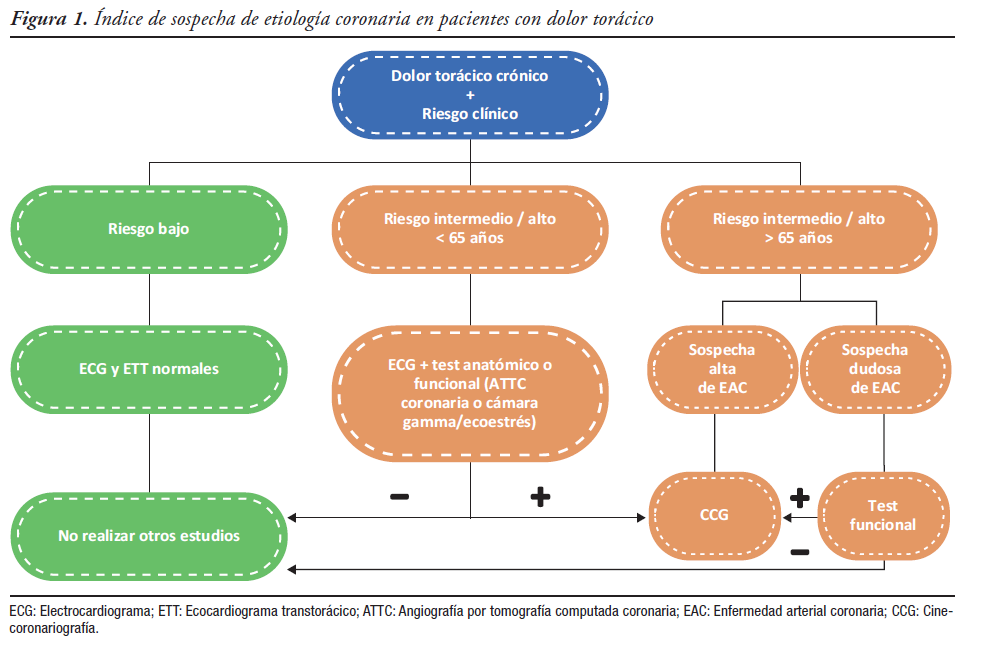Enfermedad coronaria y dolor torácico crónico: abordaje actual según las últimas guías
DOI:
https://doi.org/10.52787/agl.v52i4.262Palabras clave:
Dolor torácico, enfermedad coronaria, síndrome coronario crónicoResumen
La enfermedad arterial coronaria suele manifestarse con características típicas, producto de la oclusión parcial o total de la circulación en las arterias epicárdicas. Sin embargo, en un grupo específico de pacientes puede presentarse con síntomas no habituales. Es por esto que, al evaluar a un paciente con dolor torácico, es fundamental realizar una anamnesis exhaustiva para detallar las características de la presentación clínica así como una completa evaluación de los factores de riesgo y de los antecedentes cardiovasculares previos. De esta manera podrá evaluarse el pretest y la probabilidad clínica del paciente de presentar enfermedad arterial coronaria. Así mismo, con la ayuda de estudios complementarios, se llevará a cabo una evaluación que permita guiar futuras conductas diagnósticas y/o terapéuticas de acuerdo con el caso específico.
Citas
-1. Knuuti J, Wijns W, Saraste A, et al. 2019 ESC Guidelines for the diagnosis and management of chronic coronary syndromes. Eur Heart J. 202014;41(3):407-77. doi: 10.1093/eurheartj/ehz425
-2. Hsia RY, Hale Z, Tabas JA. A national study of the prevalence of lifethreatening diagnoses in patients with chest pain. JAMA Intern Med. 2016;176:1029-32.
-3. Fanaroff AC, Rymer JA, Goldstein SA, et al. Does this patient with chest pain have acute coronary syndrome?: the rational clinical examination systematicreview. JAMA. 2015;314:1955-65.
-4. Duronto E, Navarro Estrada JL, Benger J, et al. Consenso para el Manejo de Pacientes con Dolor Precordial. Rev Argent Cardiol. 2016;84:378-401. http://dx.doi.org/10.7775/rac.es.v84.i4.9074
-5. Gulati M, Levy PD, Mukherjee D, et al. 2021 AHA/ACC/ASE/CHEST/SAEM/SCCT/SCMR Guideline for the Evaluation and Diagnosis of Chest Pain: A Report of the American College of Cardiology/American Heart Association Joint Committee on Clinical Practice Guidelines. Circulation. 202130;144(22):e368-e454. doi: 10.1161/CIR.0000000000001029. Epub 2021 28 de octubre.
-6. 2019 ESC/EASD Guidelines on diabetes, pre-diabetes, and cardiovascular diseases. Eur Hear J. 2019: en prensa.
-7. Piepoli MF, Hoes AW, Agewall S, et al. 2016 European Guidelines on cardiovascular disease prevention in clinical practice: The Sixth Joint Task Force of the European Society of Cardiology and Other Societies on Cardiovascular Disease Prevention in Clinical Practice (constituted by representatives of 10 societies and by invited experts) Developed with the special contribution of the European Association for Cardiovascular Prevention & Rehabilitation (EACPR). Eur Heart J. 2016;37:2315-2381.
-8. Catapano AL, Graham I, De Backer G, et al. 2016 ESC/EAS Guidelines for the management of dyslipidaemias. Eur Heart J. 2016;37:2999-3058.
-9. Di Angelantonio E, Chowdhury R, Sarwar N, et al. Chronic kidney disease and risk of major cardiovascular disease and nonvascular mortality: prospective population based cohort study. BMJ. 2010;341:c4986.
-10. Daly C, Norrie J, Murdoch DL, Ford I, Dargie HJ, Fox K; TIBET (Total Ischaemic Burden European Trial) study group. The value of routine non-invasive tests to predict clinical outcome in stable angina. Eur Heart J. 2003;24:532-540.
-11. Steeds RP, Garbi M, Cardim N, et al. Scientific Documents Committee. EACVI appropriateness criteria for the use of transthoracic echocardiography in adults: a report of literature and current practice review. Eur Heart J Cardiovasc Imaging. 2017;18:1191-1204.
-12. De Bruyne B, Pijls NH, Kalesan B, et al. FAME 2 Trial Investigators. Fractional flow reserve-guided PCI versus medical therapy in stable coronary disease. N Engl J Med. 2012;367:9911001.
-13. Tonino PA, De Bruyne B, Pijls NH, et al. FAME Study Investigators. Fractional flow reserve versus angiography for guiding percutaneous coronary intervention. N Engl J Med. 2009;360:213-224.
-14. Knuuti J, Ballo H, Juarez-Orozco LE, et al. The performance of non-invasive tests to rule-in and rule-out significant coronary artery stenosis in patients with stable angina: a meta-analysis focused on post-test disease probability. Eur Heart J. 2018;39:3322-3330.
-15. Gueret P, Deux JF, Bonello L, et al. Diagnostic performance of computed tomography coronary angiography (from the prospective national multicenter multivendor EVASCAN study). Am J Cardiol. 2013;111:471-478.
-16. Neumann FJ, Sousa-Uva M, Ahlsson A, et al. 2018 ESC/EACTS Guidelines on myocardial revascularization. Eur Heart J. 2019;40:87165.
-17. Toth G, Hamilos M, Pyxaras S, et al. Evolving concepts of angiogram: fractional flow reserve discordances in 4000 coronary stenoses. Eur Heart J. 2014;35:2831-2838.
-18. Jeremias A, Maehara A, Genereux P, et al. Multicenter core laboratory comparison of the instantaneous wave-free ratio and resting Pd/Pa with fractional flow reserve: the RESOLVE study. J Am Coll Cardiol. 2014;63:1253-1261.

Publicado
Cómo citar
Número
Sección
Licencia
Derechos de autor 2022 Leandro Barbagelata

Esta obra está bajo una licencia internacional Creative Commons Atribución-NoComercial-CompartirIgual 4.0.












